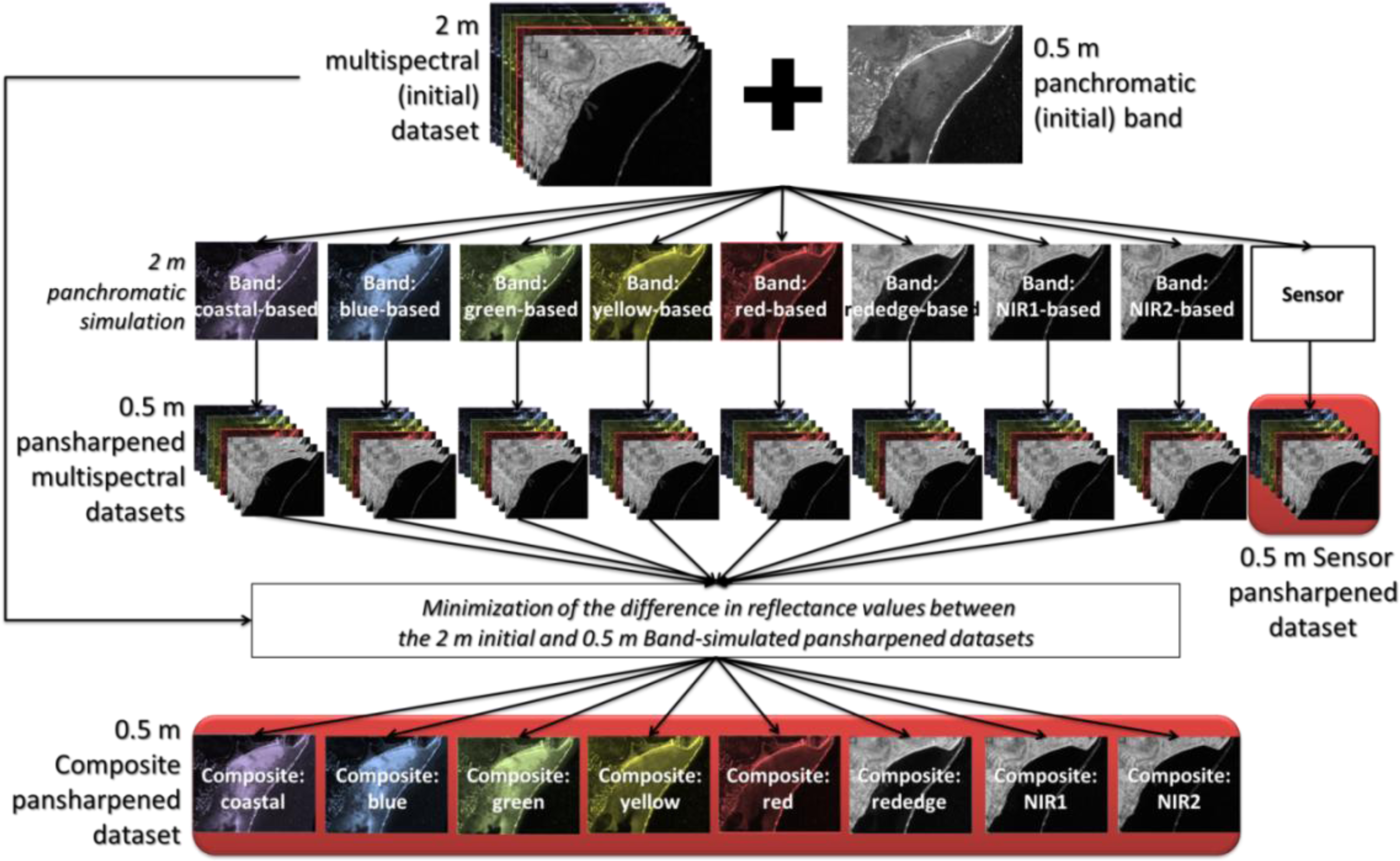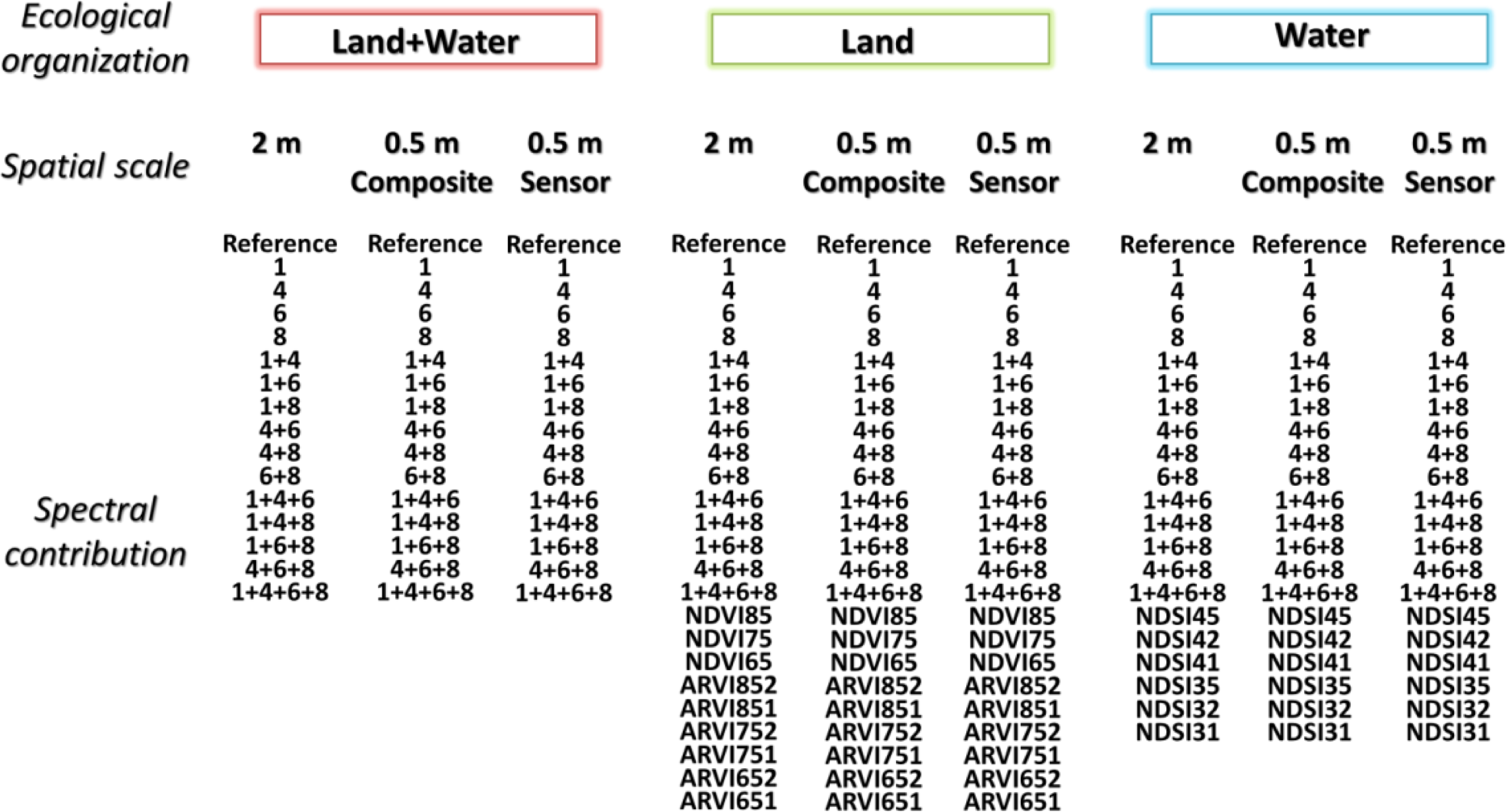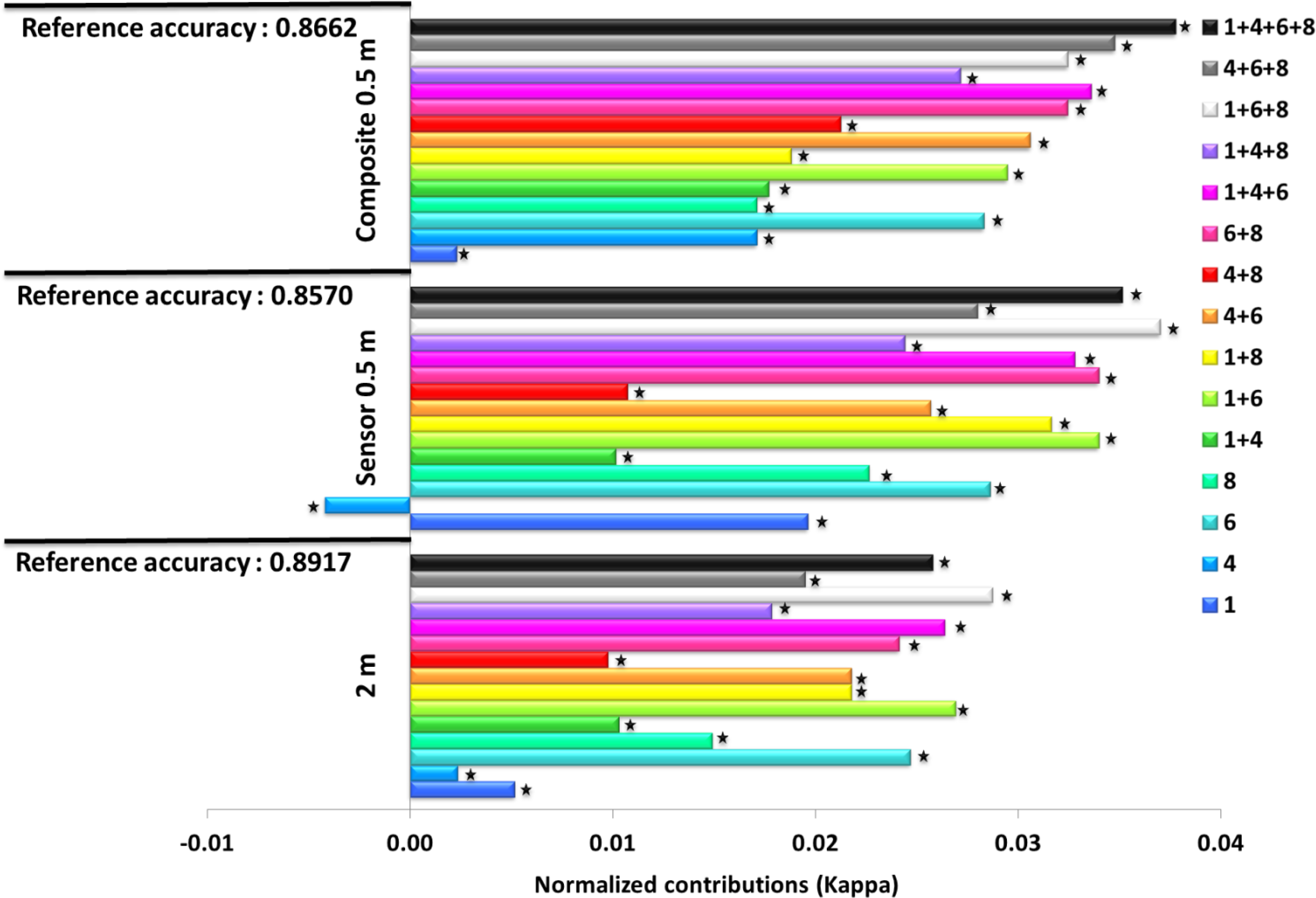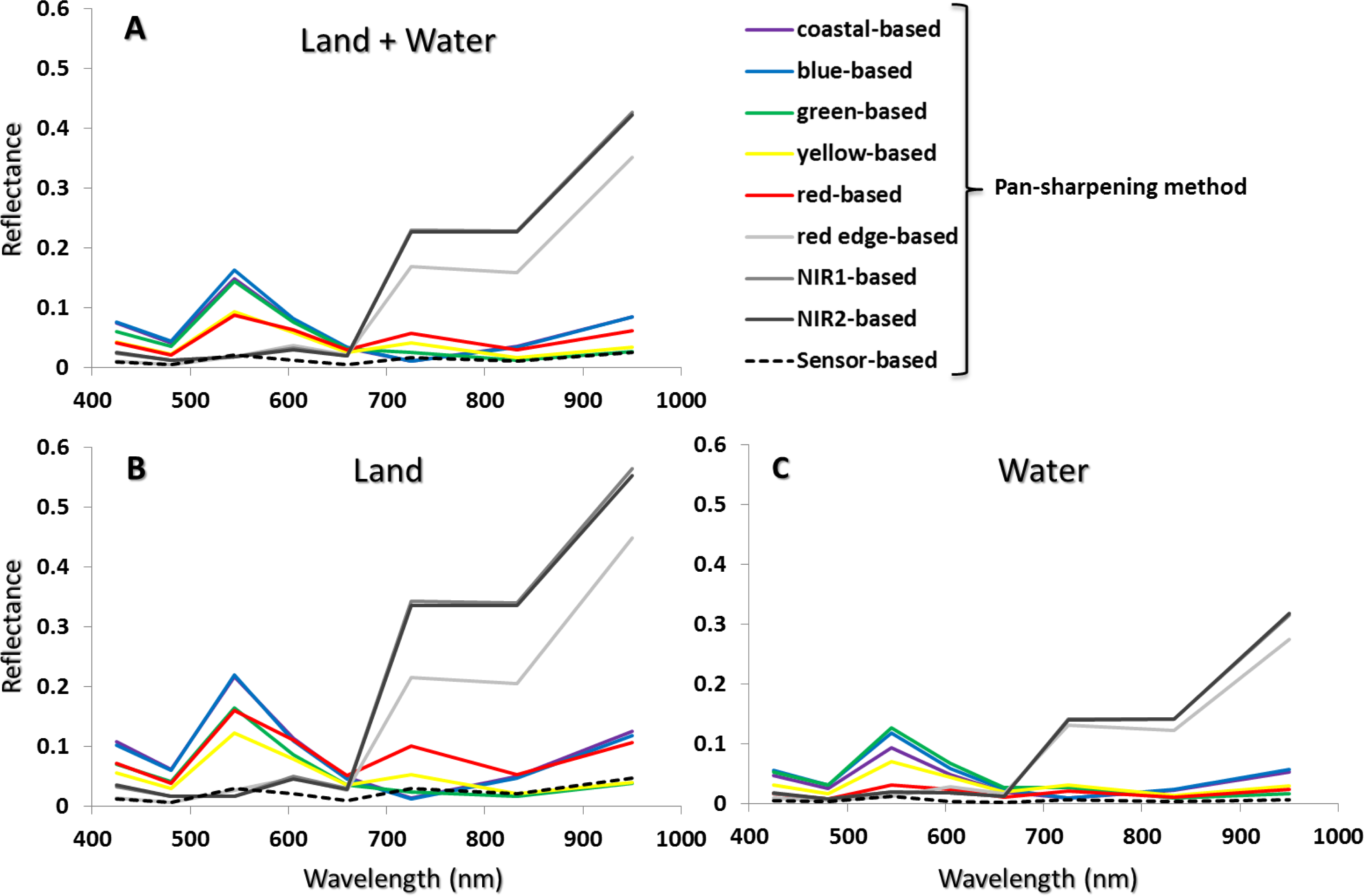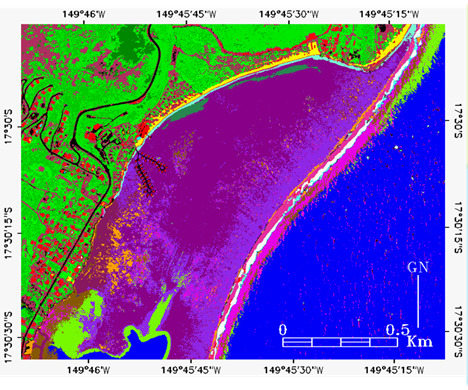3.1. Increasing Classification Accuracy by Spectral Enhancement
From the single band to the four band combination, the normalized contributions of the 15 combinations, built only with novel WV2 bands (coastal, yellow, NIR1 and NIR2) systematically increased the appa coefficient (κ) of the commonly used four band classification (
Figure 4). The overall best single and combined contributions were attributed to the red edge band (κ
gain = 0.0247) and to the coastal-red edge-NIR2 combination (κ
gain = 0.0287) (
cf.
Figure A2 in Appendix for the classification map). Adding the red edge band enabled the spectral gap occurring between the red and NIR1 bands to be bridged, enhancing the discrimination among classes that show identifiable reflectance/absorbance within this spectral range. Note that the red edge penetration into water is expected to reach 0.7 m [
33]. This assumption was confirmed by the best PA/UA results, indicating that: (1) the fleshy and encrusting algae received the highest contribution (UA
gain = 18.18%) from all combinations, including either the red edge or the NIR2 bands, (2) the hard coral thicket was strongly enhanced by the coastal-red edge-NIR2 and four band combination (PA
gain = 16.95%), (3) the tar was reinforced by all combinations, including either the red edge or the NIR2 bands (PA
gain = 11.11%), and (4) the emergent vegetation benefited from the red edge and coastal-red edge combinations (UA
gain = 10.59%) (
Table 2). Regarding the emergent vegetation and the fleshy and encrusting algae (composed of
Turbinaria spp. and encrusting algae), the importance of the integration of the red edge might be correlated with the detection of high reflectance inherent to chlorophyll organisms, also called the red-shift effect. Conversely, the red edge, sometimes called the far red, was demonstrated to correspond to the absorbance of photosystem I, while photosystem II was driven by the red wavelengths [
34]. Stretching out the QB2 spectral windows, both coastal and NIR2 favored a better distinction among coastal classes. The contribution of coastal band to emergent vegetation and hard coral thicket might be related to the detection of the first peak of chlorophyll-a [
28], hitherto undetectable for the traditional blue-bottomed sensor. Detecting beyond 1,000 nm (more than 150 nm over the QB2 upper boundary), NIR2, strongly absorbed by water, enabled the misclassifications occurring between land and water classes to be avoided. Of special relevance was the combined effect of the three and four band series, pointing out that a classification of hard coral thicket could be successful with a 400–1,000 nm spectrum range, despite the coarse spectral resolution (eight band average: 56 nm).
The most negative PA and UA contributions involved the yellow-NIR2 combination and were related to the hard coral/algae patches (losses: −20.88% and −18.38%, respectively) (
Table 2). The misclassification associated with the yellow band might be the consequence of the subtle spatial heterogeneity of water composition occurring along the coast, due to terrestrial run-off. Matching the reflectance peak of surface waters containing CDOM [
17], the yellow band might lead to misclassifications over the coastline-contiguous classes, such as the hard coral/algae patches. The overall accuracy supported this assessment, since the yellow band was the lowest contributor (0.0024), and its presence within the four band combination (coastal-yellow-red edge-NIR2) impaired the intuitively-expected best contribution. Following the advances tied to hyperspectral measurements, the WV2 yellow band coupled with
in situ measurements should be further investigated regarding information from the water column, so that the inherent optical properties (IOP) could be better modelled across regional areas.
3.2. Patterning Classification Accuracy with Spatial Enhancement
The influence of the simulation method (
cf. step 1 of the Pan-sharpening procedure, Section 2.4, and
Figure 2) on the spectral properties of at-surface reflectance was assessed by computing the absolute average difference of the training pixels per band issued from the initial (2 m) and nine Pan-sharpened MS imageries (
Figure 5). The difference was first computed based on the seamless study area, spanning the 21 ground-truth regions of interest, keeping the integrity of the reefscape irrespective of the coastline boundary (
Figure 5A). Splitting the study area into nine land and 12 water areas, two differences were calculated in order to account for the land- and water-related specificity of spectral responses (
Figure 5B,C). Overall, the sensor simulation displayed the lowest differences, irrespective of the level of the coast integrity, outperforming most of the eight band simulations. However, the sensor simulation was locally (at the wavelength scale) surpassed by some band simulations (e.g., red edge-based band simulation at 545 nm and coastal-based band simulation at 725 nm in the land + water analysis). Some spectral patterns related to band simulations emerged from the seamless and splitting analyses. While the NIR-based band simulations minimized the differences in the visible spectrum, the visible-based band simulations minimized the difference in the NIR spectrum. Conversely, the NIR- and visible-based band simulations maximized the differences in the NIR and visible spectral ranges, respectively (
Figure 5).
Based on observations of the eight band simulations (excluding the sensor simulation,
cf.
Figure 5), a Pan-sharpened composite MS imagery was built from the band-based simulation displaying the smallest difference for each spectral band (
Table 3). The resulting Pan-sharpened composite dataset thereafter provided a very high spatial resolution dataset, whilst minimizing the spectral deviation from the initially collected pixel values.
The effect of the enhancement of spatial scale on overall classification was examined as a function of the two simulation techniques employed in the Pan-sharpening procedure. The refinement of the spatial scale tended to slightly diminish the overall consistency between trained and validated pixels attendant with the measured 2 m standard four band dataset (
Figure 4). Nevertheless, the proposed composite Pan-sharpening technique (κ
loss = −0.0255) was less impacted by the traditional sensor technique (κ
loss = −0.0347). The sensor modality showed the same categorical boundaries as those of the overall 2 m performance,
i.e., highest and lowest contributions driven by the coastal-red edge-NIR2 (κ
gain = 0.037) and the yellow series, which was negative (κ
loss = −0.004). The composite modality was delimited by the coastal and four band series (κ
gain = 0.0023 and 0.0378, respectively). A pattern emerged from this latter modality, clearly separating the lowest contributions with no red edge and the highest contributions, including the red edge band.
According to previous results, we could hypothesize that the gap bridging, provided by the red edge integration into WV2 bands, was better exploited by the composite than the sensor simulation. On the other hand, the spectral deviation of the red edge signatures between the 2 m and the composite 0.5 m datasets was minimized by the coastal band, outperforming the 0.5 m sensor-driven deviation (
Table 3). This result pointed out the existing complementarities of the red edge and the coastal information, which substantially improved the signals traditionally carried by the NIR-green couple (
Table 3). Our composite simulation might also confer better results, because of accounting for the coastal band (400–450 nm), which was excluded from the sensor simulation (the WV2 Pan band spectrally starting at 450 nm). When dealing with Pan-sharpened-driven overall classification, we strongly advocate to use this proposed simulation technique in order to differentiate better among land and water classes with the integrated quasi-continuous optical spectrum.
The component substitution method, employed in this study, was based on a spectral combination of eight bands, without any spatial filtering of the Pan band. Advances in Pan-sharpening have been considerably motivated by the use of the multiresolution analysis. The principle is to decompose the imagery at various spatial resolutions, so that the details of the Pan image can be injected into the original MS dataset. The most successful decomposition functions are the generalized Laplacian pyramid and redundant shift-invariant wavelet and contourlet filtering of the Pan band [
35].
The fusion products derived from the sensor and composite techniques were empirically assessed as spectral difference with the original dataset. Some protocols exist for evaluating the quality of fused images, such as the Khan’s protocol, which integrates the properties of other protocols in order to define spectral and spatial quality indices at full scale [
35]. In the near future, the composite technique will be assessed with those recent progresses in quality measures in order to compare its efficiency with other techniques.
At the patch level, scaling up the spatial resolution led to an overall rise of spectral contributions (
Tables 4 and
5). The sensor technique (
Table 4) displayed the highest contributions in both land and water classes, namely the hard coral thicket (PA
gain = 30.36% with coastal-red edge-NIR2), tar (UA
gain = 18.94% with NIR2, coastal-NIR2, coastal-yellow-NIR2 and coastal-red edge-NIR2 series), hard coral bommie (UA
gain = 17.81% with the four band combination) and emergent vegetation (PA
gain = 16.67% with red edge and red edge-NIR2). The lowest contribution was attributed to the composite modality, involving the yellow band, which contributed in decreasing the UA hard coral thicket by −9.29%. However, the sensor simulation (
Table 5) produced the three remaining lowest contributions, namely emergent vegetation (UA
loss = −8.73% with the yellow-NIR2 combination), reef matrix (PA
loss = −7.89% with yellow-red edge and yellow-red edge-NIR2 associations) and mature vegetation (PA
loss = −7.04% with coastal-yellow and coastal-yellow-NIR2 combinations). While the average maximum PA and UA increased with spatial refinement, the range computed between average maximum and minimum PA and UA increased and decreased for land and water classes, respectively (
Table 6). Those findings underlined two gradients of the accuracy stability: one for land classes ranging from high to low resolution; the other one for water classes ranging from low to high resolution. Following the pattern deciphered in the 2 m results, the red edge, associated or not with NIR2, was of profit for the emergent vegetation and considerably beneficial when combined with coastal, NIR2 and even yellow for both hard coral classes (
Tables 4 and
5). These results could be explained by the same arguments mentioned in Section 3.1, namely spectral continuity, offered by the gap fulfilled by the red edge, detecting the reflectance/absorbance of chlorophylls, and yellow, as well as the spectral extension of the gamut with coastal and NIR2, sensing the first peak of chlorophyll-a and water, respectively. However, singly considered, the yellow band created discrepancies over hard coral thicket (UA
loss = −9.29%), as well as hard coral/algae patches (UA
loss = −6.72%). The yellow-driven counter performance might be due to the suspended sediment in the water column, since hard coral/algae patches attested to it (
cf. explanation in Section 3.1), but also to the method itself, since the spectral difference between the 2 m and composite 0.5 m was the highest (
Table 3). When dealing with Pan-sharpened images at the patch level, it is recommended to adopt the sensor approach to improve the classification accuracies of both land and water classes.
3.3. Classification Accuracy According to the Coast Integrity
The splitting of the original 2 m coast into its land and water bodies differentially altered their respective overall classification accuracy (
Figure 6). While the kappa coefficient related to land barely reduced to 0.8894 (κ
loss = −0.0023), for water, it decreased to 0.8182 (κ
loss = −0.0735). Considering only the land, the lowest spectral contribution was attributed to the yellow band (κ
gain = 0.0029), and the most gaining series involved coastal-red edge-NIR2 and a four band combination (κ
gain = 0.0223). Concerning vegetation indices, all ARVI and red-NIR1 NDVI brought negative contributions, while red-red edge NDVI and red-NIR2 NDVI supported slight contributions (topping at 0.0045 for the latter index). As for water partition, the yellow band brought the least important contribution (κ
gain = 0.0022), and the prime combination was based on the coastal-red edge-NIR2 association (κ
gain = 0.0422). All hard coral-related NDR furnished valuable information, increasing by 0.0011 (green-red, yellow-blue, yellow-red), 0.0022 (green-coastal, yellow-coastal) and 0.012 (green-blue). Regarding the land classes, the yellow band might be the least important contributor, since its spectral sensitivity does not correspond to any primary reflectance peaks of the vegetation pigments (
cf. [
36]). Although the yellow band provided the smallest contribution to both realms, it seemed that it was more prejudicial to the water class, given the best contribution was deprived of the yellow band. Once again, the spectral matching of the reflectance peak of CDOM-borne waters and the yellow band might entail inconsistencies over water classes somewhat masked by suspended matter in the water column. Arguing in favour of the increased power of discrimination with the quasi-continuity of the spectrum, the three and four band combination furnished the best results. The contribution of the land band ratios might be associated with the well-recognized spectral behaviour of the chlorophyll vegetation: strong absorption and reflection in the red and NIR wavelengths, respectively. Even if the traditional red wavelengths got involved in both ratios, the two related NIR wavelengths belonged to the novel WV2 spectral capabilities, the red edge band, bridging the traditional QB2 red and NIR1 bands, and the NIR2 band, considerably stretching out the NIR1 band to longer wavelengths. These findings unequivocally underscored the better proficiency of red edge and NIR2 bands for detecting vegetation reflectance compared to the commonly used NIR1 band, as found by [
37]. Even though ARVI was better recognized to reduce the atmosphere effects than the NDVI index [
38], it only worsened the classification accuracy of land classes. However, this counter-performance might be attributed to the fixing of the γ value at one. Provided with a γ value equalling 0.7, the ARVI index, applied to atmospherically uncorrected data, was demonstrated to be most capable of decreasing the atmospheric influence [
38]. We therefore suggest that various γ values should be tested in further vegetated land classifications.
At the patch scale, the integrative approach of the coast turned out to be more prejudicial to land patch classes and more profitable to water patch classes, regardless of the PA and UA (
Table 6). When singly considered, the land patch classes only benefited from the best contributions of 9.72% for UA emergent vegetation (with red edge band), of 8.89% for PA grass (with red edge, coastal-red edge, red edge-NIR2 and coastal-red edge-NIR2 combinations) and showed the least efficient contributions of −2.3% for PA bare soil (with yellow-NIR2, red edge-NIR2 and yellow-red edge-NIR2) and of −2.36% for UA roof (with yellow-NIR2) (
Table 7). While the best contributions stemming from vegetation indices reached 3.85% for PA emergent vegetation (with red-NIR2 NDVI), the worst contribution was attributed to this same index with PA bare soil (
i.e., PA
loss = −2.3%). The grass and emergent vegetation classification accuracies were successively improved by the red edge band and red-NIR2 NDVI. As previously mentioned, the value of the red edge band might be strongly associated with the detection of reflectance/absorbance peaks of chlorophylls-a and -b and the utilization of NIR2, contiguous to the short-wavelength IR (SWIR). The resulting NDVI might optimize the detection of chlorophyll reflectance in avoiding the detection in the very NIR of vegetation absorbance attendant with its phenology and/or vigor [
39].
On the other hand, singly considered, the water patch classes received a considerably prime contribution of 40% for PA hard coral bommie (with the coastal-NIR2 combination), 30% for UA hard coral bommie (with red edge-NIR2 and coastal-red edge combinations) and the poorest contributions of only −3.85% for UA hard coral/algae patches (coastal-yellow-NIR2) and of −1.18% for PA reef matrix (with the yellow band) (
Table 7). Linked with the coastal, red edge and NIR2 bands, the strong enhancement of hard coral bommie might be explained by the detection of the first peak of chlorophyll-a, red-shift effect and, lastly, SWIR or the refinement of the land-water discrimination. The UA hard coral bommie benefited from green-coastal hard coral-related index (UA
gain = 11.06%), while the PA reef matrix was lowered (PA
gain = 4.71%) with the green-red, yellow-blue and yellow-red hard coral indices. The green-coastal NDR result firmly concurred with the finding of [
28], demonstrating that it was likely to be a robust proxy for detecting coral pigments. Since this band ratio is required to be sensitive to pigments showing a high reflectance in the coastal band and a low reflectance in green coastal, the peridinin might turn out to be a good candidate. The difference existing between average maximum and minimum PA and UA was obviously lower for both land and water classes when the coast was examined according to a dichotomous approach (
Table 6). This result indicated a higher stability in accuracies of the cut-off than the integrative scene, which might be due to the spectral and contextual specificity of the terrestrial and aquatic classes.
The increased contributions of the spectral combinations could be the consequence of the dramatic diminution of the overall classification accuracy. It is noteworthy that the overall classification accuracy of the integrated scene was greater than that of the fragmented coast. This result might reveal the “emergent properties that arose from spatial coupling of spectrally-derived local ecosystems” [
40]. This citation, referred to as the concept of meta-ecosystem, could be defined as a “set of ecosystems connected by spatial flows of energy, materials and organisms across ecosystem boundaries” [
40]. The bespoke coast-ecosystem could adequately match such a concept that will target ecological issues, commonly restrained to land and marine realms exclusively, in considering tropical watershed and nearshore ecosystems as spatially interconnected nodes of ecological processes across different spatial scales. Fluxes of materials and organisms occurring at the watershed/nearshore interface could, thereby, be looked at using a powerful theoretical framework. Monitoring the spatial assemblage of vegetation productivity and diversity (using red edge-NIR2 NDVI) with sedimentation (using yellow band) will not only enable the bilateral relationships to be quantitatively assessed, but also provide the potential to study the reciprocal influences that the hard coral/algae patches and the emergent/mature vegetation exert on each other’s functioning (coastal protection and sedimentation, respectively). Merging the coast-ecosystem concept with the WV2-based spatial patterning will furnish a timely method to analyze the structure and dynamics of coral-related meta-ecosystems at various scales and model the influence of watershed management on reef maintenance of the ecological services.



